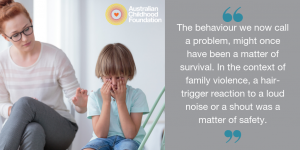
10 Key Messages for Schools About Functional Behaviour Assessment
This blog article was written by Dr Sonja Vanderaa,
Senior Training Consultant at the Australian Childhood Foundation.
Have you ever wondered what a functional behaviour assessment is? Or how it can help the children and young people you work with? So much has been written about functional behaviour assessment (FBA) that it can be hard to know where to start reading.
So, here is my summary, of ten key messages. I hope you find them helpful as you reflect on a student whose behaviour you find challenging. They are key points to which I return when feeling overwhelmed, in an effort hold the whole child in mind, and to hold onto the hope that change is possible.
1. Functional Behaviour Assessment (FBA) is built on three key assumptions: behaviour is purposeful, predictable and changeable (Crone & Horner, 2003).
2. FBA is “a process for gathering information which can be used to maximise the effectiveness and efficiency of behavioural support” (O’Neill, Horner, Albin, Sprague, Storey & Newton, 1997, p. 3).
3. The first step in an FBA is child-centred planning. This involves listening to the child and their family, to get a sense of the child as a whole person, beyond their challenging behaviour. Who are they are? What are their interests, their strengths and needs? What is important to them? What might increase the child’s sense of inclusion, belonging and social connectedness? What does the child like/tolerate/dislike? Where are the opportunities for choice and control in their life?
4. FBA is about listening to the message behind the behaviour. It’s about wondering what might the person be getting, avoiding or communicating through their behaviour. FBA invites us to stay open and curious, to wonder how the behaviour might meet the needs of the child. How might it have protected the child in the past? Was it a form of comfort seeking? What might the child get, avoid or communicate through their behaviour? When is the behaviour most/least likely to occur?

5. Trauma based behaviour is functional at the time in which it develops as a response to threat (Principle number 6, Australian Childhood Foundation, 2015). For example, a young person might run from the classroom to climb high up onto a roof top.
Over time we might learn of the student’s experience of family violence. We might notice that sudden noises are triggers: the clatter of a tipped-over chair, the playful whack of textbook on desk, a teacher’s raised voice.
We can think of exiting class and climbing onto a roof as maladaptive and unsafe. But the behaviour we now call a problem, might once have been a matter of survival. In the context of family violence, a hair-trigger reaction to a loud noise or a shout was a matter of safety.
Making sense of behaviour as adaptive can help educators to take it less personally. It also invites us to look beyond what is observable and to understand the importance of the student’s story. We don’t need to know all the details, but if we can think like detectives, picking up clues about triggers, it can be empowering, decreasing shame and increasing our ideas about what to do.
6. FBA locates a problem behaviour within the environment, not within the child. The focus for changing behaviour then becomes understanding and changing the context within which the behaviour occurs (O’Neill et al.,1997).
A function-based support plan describes “what we will do differently. It is the change in our behaviour that will result in improved behaviour of the focus person” (O’Neill et al., 1997, p. 65). Trauma sensitive FBA, for example, invites educators to consider structuring the school environment for physical, social, emotional and academic safety.
7. FBA is not just about decreasing problem behaviours. A major priority in any FBA is the systematic, explicit teaching for social and emotional learning. Long-term positive behaviour change depends upon students’ increased use of appropriate skills (Goh & Bambara 2012).
8. In the context of schoolwide positive behaviour support, FBA is considered a key approach for 1-5% of a school’s students with significant social and emotional learning needs.
9. We might not always engage in an FBA, but thinking about behaviour as communication is a powerful and positive first step. When we don’t listen to the messages behind behaviour, as Gary LaVigna says, “we are requiring that the person not whisper to us, but shout at us; and it is the “shout” we then call severe and challenging behaviour” (2009, p.14).
10. Trauma sensitive FBA values the child’s inner world. A good FBA helps us, the adults, to increase our empathy and capacity to attune to the child’s experience. Questions to reflect on might include: Where is the child’s voice in this assessment? When we consider the child’s history, what are the broader themes that emerge, e.g. loss and grief, trust, connection seeking, regulation, emotional age versus chronological age, shame, anxiety, identity?
The Australian Childhood Foundation offer Functional Behavioural Assessments as a part of our School Support Services. If you are interested in learning more or engaging us to undertake a Functional Behavioural Assessment at your school, please contact us and we’ll be in touch soon.
References
Australian Childhood Foundation (2015). 9 Plain English Principles of Trauma Informed Care http://childhoodtrauma.org.au/2015/april/trauma-informed-care
Crone, D., & Horner, R. H. (2003). Building positive behaviour support systems in schools: Functional behavioral assessment. New York: The Guilford Press.
Goh, A. E., & Bambara, L. M. (2012). Individualized positive behavior support in school settings:
A meta-analysis. Remedial and Special Education, 33(5), 271-286. doi:
0741932510383990
O’Neill, R. E., Horner, R. H., Albin, R. W., Sprague, J. R., Storey, K., & Newton, S. J. (1997). Functional assessment and program development for problem behavior: A practical handbook (2nd ed.). Pacific Grove, CA: Brooks/Cole.
LaVigna, G., Willis, T.J., Marshall, J.Q. (2009). Positive practices in behavioural support through
non-linear applied behavioural analysis: Facilitator’s Manual. Institute for Applied
Behaviour Analysis, Los Angeles, CA.
